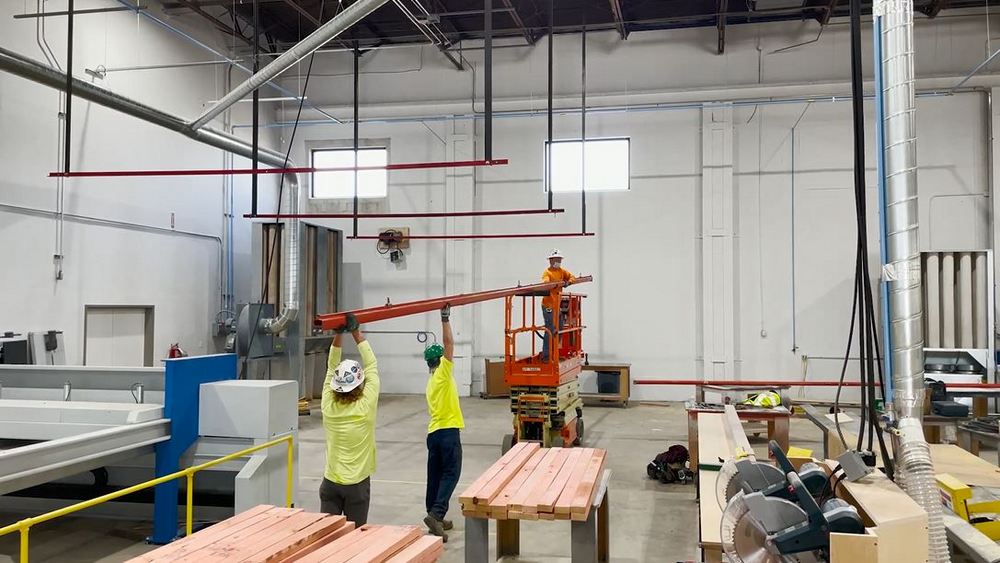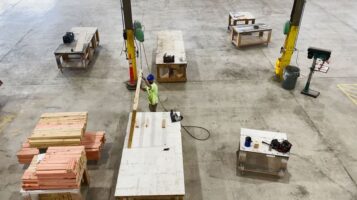
3 advantages of leveraging prebuild facilities
By Nick Effenheim
With the increased demand for speed, safety and precision on construction sites, many in the industry are looking offsite to tackle these challenges head on and ensure the certainty of results our clients have come to expect. One way JE Dunn teams are doing this is through our prebuild facilities, where we can incorporate value-added steps into components that get sent to construction sites for installation. While this is very similar to prefabrication, the distinction is in the scope of components prebuild facilities offer.
When people hear prefab, they think of modular components built in a manufacturing facility and assembled onsite. We do create these types of modular assemblies in our facility, but we also create individual components and component kits for trades people to install in the field. We use the term “prebuild” because it encompasses prefab, giving construction teams a multitude of options, packages, components, etc. to find the best approach for each project.
One thing the pandemic has taught us is that teams must remain nimble and deal with unexpected challenges on any given day. That’s when the advantages of using prebuild facilities become the most apparent, allowing us to improve safety, speed and schedule with reliable results.

1) Safety
We can make drastic improvements in safety in a couple different ways. First, the equipment we use in our prebuild facility is much safer than traditional tools that would be used on a jobsite. The facility gives us the opportunity to handle material with specialized equipment such as forklifts, overhead cranes, vacuum lifts, tables that raise and lower, etc., whereas on a jobsite, teams may not have access to all this equipment in every situation. In a shop, almost all material can be handled with some type of equipment, which eliminates some of the potential risk to workers onsite by moving the task to a controlled environment.
Second, having a facility set up for building common components provides a very consistent environment for employees to work in every day. This is much safer than a jobsite, because the construction site continuously evolves as the building is being constructed. It is a full-time job on a big project to make sure safety is one step ahead of construction. In the shop, the size and type of part we are creating changes, but the site never does. This is a huge advantage to keep a safe workplace.
Everyone knows that a clean site makes for a safe site, and in our facility, we have a lot of equipment and systems in place to keep it tidy. Most of the time, our people are working on tasks at work-bench height in the shop. This is a big change from the construction site where people work on items at various elevations, which introduces the potential for unsafe behavior. If we need to work on something that is over our head in the shop, we can typically use one of our personnel lifts to access the work—which is not always the case on a site.

2) Speed and consistency
Another advantage prebuild facilities offer is the ability to produce components and assemblies much faster than is capable on a construction site. Our equipment in the shop is very accurate, so some of it doesn’t rely on someone following a line or hitting a mark. Most of our cutting is completed using computerized-numeric controlled equipment, which ensures we are producing very consistent components.
3) Schedule
By shifting work offsite and delivering the materials as they are needed, we can meet—or in some cases compress—schedules that seem to be getting shortened more and more all the time. The schedule is also helped by the modular assemblies and kits produced at the facility because much of the assembly has been completed of site, in addition to just the individual components.

Prebuilding takes planning
Planning is very important. It takes information and regular communication from the team onsite for a prebuild facility like this to be successful. Instead of ordering a unit of plywood and having the carpenters figure out how it all lays out and goes together, someone needs to have a plan of how it will go together before the material ever arrives to the construction site.
When building components are assembled offsite, you also must have the ability to design the components you will be fabricating in the shop. Every component being constructed requires some level of design to be assembled onsite in a way that meets the requirements of contract documents and overall design. This takes extreme coordination and constant communication between team members to execute successfully.
Pulling it all together
Having specialized equipment and a facility to create components is great, but it really comes down to having a workforce trained to operate the equipment—and retaining that workforce to ensure long-term results. Top-notch construction supervision professionals who can explain the benefits of using prebuilt materials and effectively communicate the applicability of these materials is also critical to the success of using this construction method.
Nick Effenheim is senior superintendent at JE Dunn Construction.


 Join our thriving community of 70,000+ superintendents and trade professionals on LinkedIn!
Join our thriving community of 70,000+ superintendents and trade professionals on LinkedIn! Search our job board for your next opportunity, or post an opening within your company.
Search our job board for your next opportunity, or post an opening within your company. Subscribe to our monthly
Construction Superintendent eNewsletter and stay current.
Subscribe to our monthly
Construction Superintendent eNewsletter and stay current.